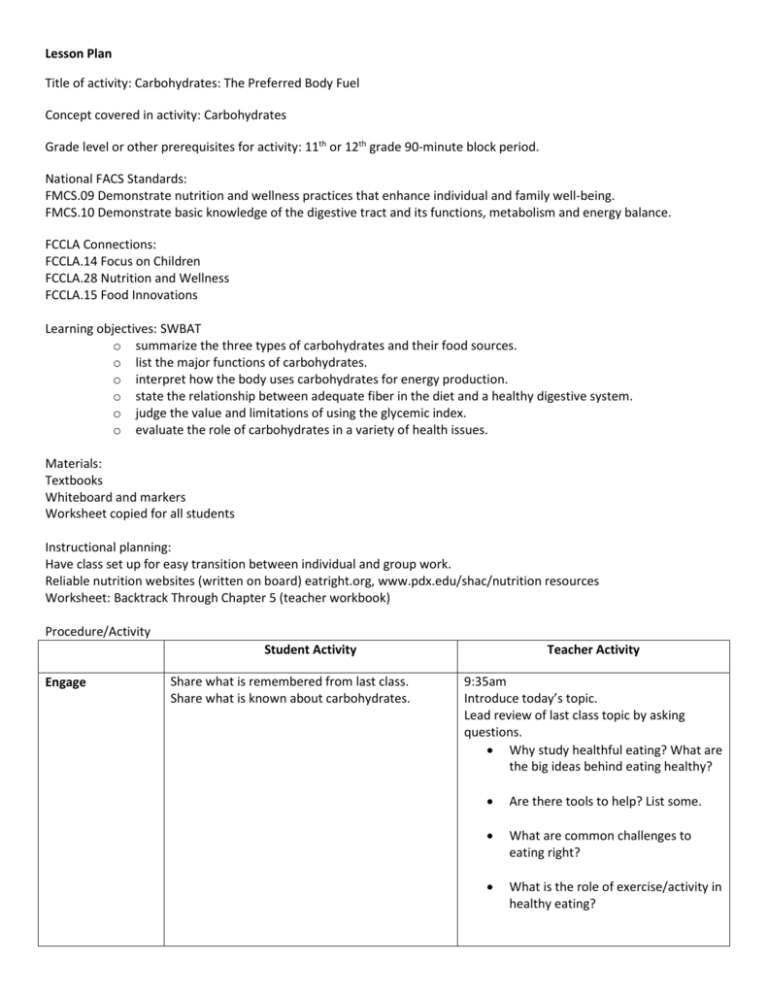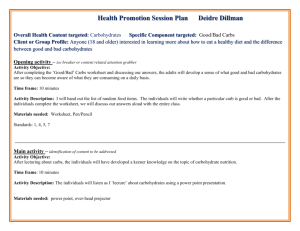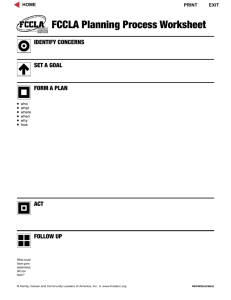File
advertisement

Lesson Plan Title of activity: Carbohydrates: The Preferred Body Fuel Concept covered in activity: Carbohydrates Grade level or other prerequisites for activity: 11th or 12th grade 90-minute block period. National FACS Standards: FMCS.09 Demonstrate nutrition and wellness practices that enhance individual and family well-being. FMCS.10 Demonstrate basic knowledge of the digestive tract and its functions, metabolism and energy balance. FCCLA Connections: FCCLA.14 Focus on Children FCCLA.28 Nutrition and Wellness FCCLA.15 Food Innovations Learning objectives: SWBAT o summarize the three types of carbohydrates and their food sources. o list the major functions of carbohydrates. o interpret how the body uses carbohydrates for energy production. o state the relationship between adequate fiber in the diet and a healthy digestive system. o judge the value and limitations of using the glycemic index. o evaluate the role of carbohydrates in a variety of health issues. Materials: Textbooks Whiteboard and markers Worksheet copied for all students Instructional planning: Have class set up for easy transition between individual and group work. Reliable nutrition websites (written on board) eatright.org, www.pdx.edu/shac/nutrition resources Worksheet: Backtrack Through Chapter 5 (teacher workbook) Procedure/Activity Student Activity Engage Share what is remembered from last class. Share what is known about carbohydrates. Teacher Activity 9:35am Introduce today’s topic. Lead review of last class topic by asking questions. Why study healthful eating? What are the big ideas behind eating healthy? Are there tools to help? List some. What are common challenges to eating right? What is the role of exercise/activity in healthy eating? Start discussion of carbohydrates with class. Write concepts on the board as the students brainstorm. Explore Explain Think of how topics on board can be categorized. Read assigned section of textbook. With a group research given topics using the book and other resources. One student will record what is discovered. Think of how to present research to the class, assign roles for the presenting. Present information to the class. Actively listen and take notes while others present. Ask questions if things are still unclear. Guide to some of the following concepts: fiber, bodies main source of energy, refined sugar and common misconceptions: carbs=bad, carbs=grains. 9:50 Help students categorize their ideas into 6 topic areas. Break students into 6 groups, aligning each group with a topic area and chapter section. Facilitate as students research their topics. Help students decide how to present their information to the rest of the class. Give students 10 minutes, checking in to guide them and overcome obstacles. If students can’t find the topic in their books suggest they use their phones to access reliable websites (listed on board). 10:20am Facilitate as groups present making sure misconceptions are corrected and explained. Encourage the group to consider using the whiteboard to write or map key concepts and/or refer the class to the text for important term definitions. When presentations are done ask if any questions remain. Ask if any students from the class who didn’t research the topic would volunteer to describe what they learned. If they get it wrong facilitate a correct description. Elaborate Critically answer the questions on the worksheet 15 min. Use textbook as resource. Write answers in their own words. Share answers from the worksheet in class review. Evaluate Engage in discussion of how carbohydrates relate to healthful eating. Turn in worksheet. Conduct fist-to-five to see if students need any areas covered more. 10:40am Hand out worksheet; Help students draw connections between concepts as they work on the worksheet. Clarify key concepts and connections as students share their worksheet answers. Ask if there are further questions. 10:55am Closure: Lead discussion on how carbohydrates relate to the larger concept of healthful eating. Help students draw connections. Facilitate with topical questions. What are new concepts that came up that relate to healthful eating? (i.e. fiber). How might you discuss carbohydrates with someone who thinks they’re bad for you? Should some people eat more carbs than others? What sources of carbs are more healthful than others? Announcements and Pledge (Over Intercom): 11:05am Assessment Formative: As I work through the lesson with my students I will be formatively assessing what they already know and how well they are learning using several techniques. The brainstorm at the beginning will guide me to see what students already know as well as different ways of thinking that I will need to address. The class discussion gives me the opportunity to again see what the students know and what they are learning. The fist-to-five will further assess how students are grasping the material as well as their confidence in their understanding. The informal presentations of key concepts also allow for me to assess whether or not students are grasping the important concepts and address mistakes and misconceptions as they arise. Summative: The worksheet that the students will complete at the end of the lesson includes critical thinking questions that will show what they have learned as well as if they can apply the concepts to real-life scenerios. Anticipated misconceptions/ alternative conceptions: Carbs are bad Carbs are grain Carbs make you fat Accommodations/modifications of activity: Make sure student with para is in a group that is inclusive. If some groups are taking longer to find their topics see if another group that is done can research a couple of their topics for them. Call on students who often don’t speak up when you know they have the right answer to share (i.e. “Danny I know you have a great answer to this would you like to share or would you like me to share what you have written”. Gain private permission first when walking around) Post Lesson Reflection: To what extent were lesson objectives achieved? (Utilize assessment data to justify your level of achievement) What changes, omissions, or additions to the lesson would you make if you were to teach again? What do you envision for the next lesson? (Continued practice, reteach content, etc.)



